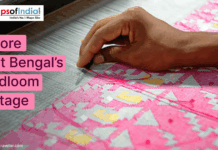The Aipan Art form is on the surge in the hands of fashion designers who are infusing pieces of history into modern apparel and accessories. By weaving these traditional rice-flour designs into clothing, they are marketing the rich culture of Uttarakhand and catering to the international audience.
It strikes an energetic and vibrant note that Aipan patterns decorate dresses and various homeware items, appealing to those looking for cultural and traditional values. With the ancient craft becoming popular in the fast-growing fashion world, artisans and consumers benefit.
What is Aipan Art?
Traditional Aipan Art refers to the woodcraft used to decorate with drawings made from rice flour from Uttarakhand, India. Flour-based motifs are often sketched on floors and walls during various festivals, making this art unique. This art is important because it represents the rich culture of the region.
Most of these decorations, as pieces of folk art, are divisible into numerous geometric and symbolic designs involving nature and spirituality. Apart from decoration, Aipan is used to draw on walls to call for plenty and wealth in the homestead.
Significance of Aipan Art
The art of Aipan is culturally essential in Uttarakhand. It is used to decorate houses and places during festive occasions and rituals. This unique practice helps people reconnect with society’s past and rich heritage.
In addition, Aipan also serves as a form of storytelling. Each design embodies the ideals and philosophies of the people made towards each pattern. While maintaining these delicate rice flour patterns, the artisans are preserving the intricate history of their region and providing a strong sense of identity to the younger generation.
How To Draw Aipan
Drawing Aipan is a labour-intensive process. It starts with a plain background, preferably wood or stone. The craftsmen prepare the canvas by evenly coating it with rice flour and water to make a paste, which becomes the base of the patterns.
The application uses simple tools or fingers to mass-produce sharp, clean lines. Many artists focus on symmetry, starting from the middle, which helps mitigate symmetry issues during the outward process. Through this strategy, skill and tradition are present in the creation of Aipan art.
Forms of Aipan Art
Aipan art features multiple styles, each with a touch of creativity. The most popular types include Ghar (home) Aipan, which is meant for daily puja (worship), and Bhumi Aipan, which is generally drawn on the ground during festivals.
Another notable type is Devi Aipan. This type is meant for God and contains beautiful designs that are prayer offerings. Everything has a distinct role in this, and all patterns are beautifully scribed on rice flour.
Importance of Lines and Dots in Aipan Art
Aipan Art is concerned with Lines and dots because they depict harmony and balance within art pieces. Each of the established Lines has different meanings, which relate to particular types of Nature or even experiences in life. These lines are mesmerising compositions, making you glued to the art.
Every one of these designs heavily relies on dots, which depend on lines called ties in graphical art, which make the whole picture look. Iot 9 suggests that combining lines and dots in a picture indicates a wealth of joyful events and good things happening in the territory of Uttarakhand. Everything together invokes traditional consensus to an art form embracing the country’s beliefs through remarkable talent.
Mathematical Patterns Found in the Aipan Art
Aipan Art is a masterpiece that challenges mathematics in its creation. Many patterns are formed using basic geometric figures such as squares, circles, and triangles, and arranging these forms results in an aesthetic appeal.
The beauty in Aipans’ layouts indicates the mastery of symmetry and proportions. These elements enhance a piece’s pleasing appearance and give it cultural value, rooting it into the world’s traditions as an expression of art and design.
Aipan Art’s Use of White and Red
In Aipan Art, red and white are prominent and highly regarded symbols in Uttarakhand. Red is bright in colour, which indicates ‘Shakti’, energy, and a good omen; white symbolises purity and peace. The colours are attractive together, especially in rice flour designs.
This combination beautifies the artworks and projects the sacredness of spirituality in Aipan Art. These colours are used during the region’s important traditional occasions and celebrations to call upon good blessings and positive energies.
Difference Between Rangoli and Aipan
Rangoli and Aipan are types of folk art, but their styles come from different cultures and parts of India. Rangoli uses coloured powder or flower petals to make beautiful patterns, which is done nationwide during festivals.
Aipan is unique to Uttarakhand and uses rice flour paste. Its colours are predominantly red, representing purity, and white, representing devotion. In contrast, Rangoli is multicoloured.
Reviving Aipan Art in Modern Fashion Markets
Introducing Aipan Art into fashion markets beautifully blends contemporary design with tradition. This innovative approach, where ancient crafts are applied to modern clothing, home decor, and accessories, breathes life into intricate rice-flour designs. This represents multiculturalism, where Aipan is appreciated globally and cherishes the roots of Uttarakhand’s culture.
Local artisans who are fairly compensated for their work ensure the brand’s authenticity, which helps sustain the livelihood of artists and keep the art alive. Unique pieces telling a story are in high demand, thus making Aipan-inspired creations popular.
With the adoption of technology and social media platforms, artists can display their works beyond geographic limits. The increasing popularity of ethnic wear is yet another reason that sparks interest in traditional crafts like Aipan Art. As this revival goes on, it gives promising hope that several generations will be able to enjoy and appreciate the wonder of Uttarakhand’s artistic heritage through modern updates in fashion.




